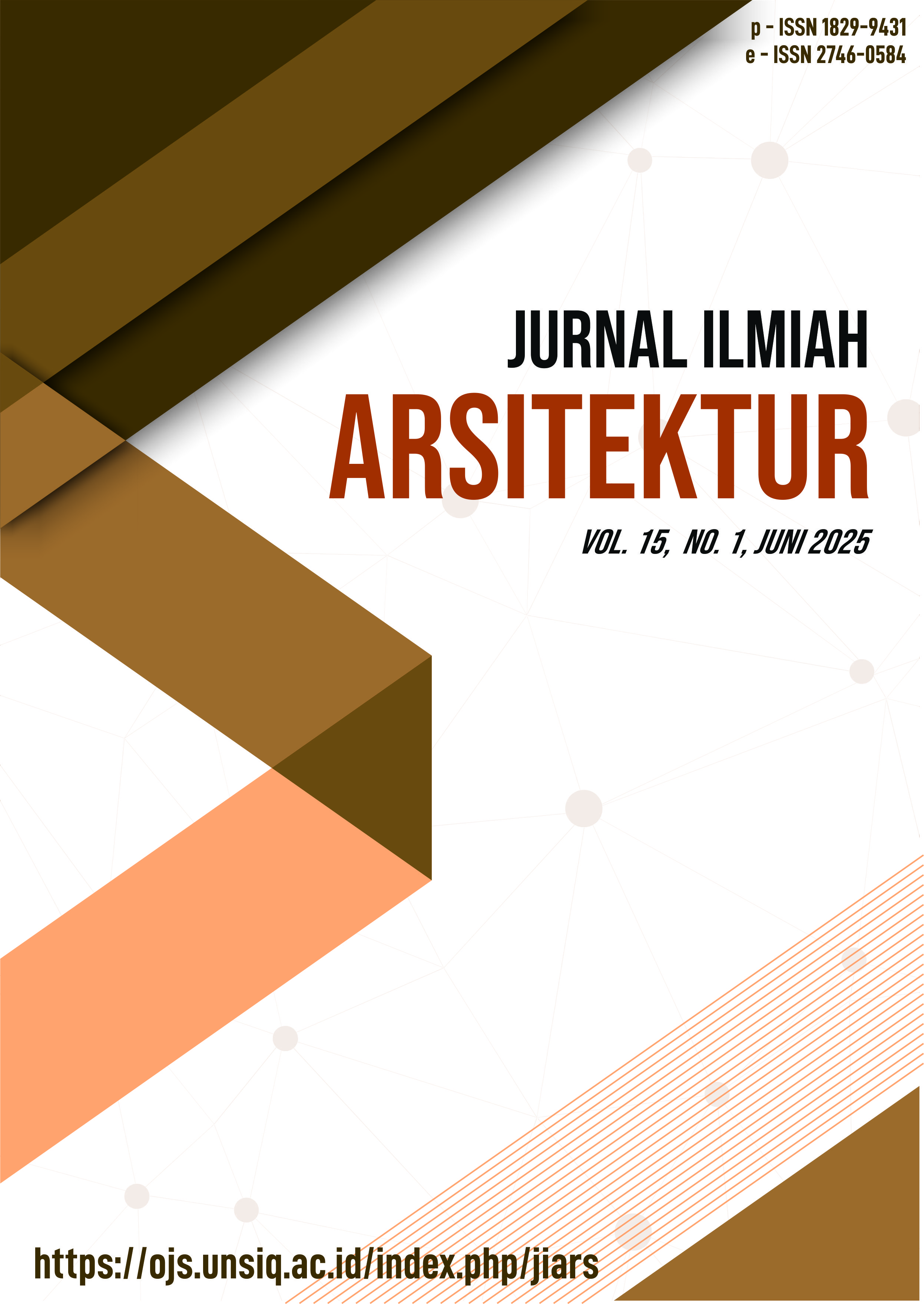SOCIAL INTERACTION SPACES IN KAMPUNG PASIR GINTUNG, BANDAR LAMPUNG, INDONESIA
DOI:
https://doi.org/10.32699/jiars.v15i1.9202Keywords:
adaptive, kampung, social space, urbanAbstract
The rapid growth of settlements in Indonesian metropolitan areas compels migrants to establish territories spontaneously, resulting in increasingly dense communities and the need for deliberate social spaces. These spaces emerge organically among residents who share long-term living experiences, cultural backgrounds, and daily activities. This study explores the characteristics of communal spaces in urban kampungs using a qualitative narrative method. Data were collected by observing the Sukamampir road corridor in Pasar Gintung, Bandar Lampung, Indonesia. The findings show that residents have transformed the road corridor into meaningful spaces for interaction, focusing on gathering activities at specific points. Given the limited spatial resources in the kampung, the study examines how citizens adaptively create places for social interaction within the remaining available areas. Activities such as sitting, standing, playing, eating, and buying and selling food occur within the corridor, facilitating daily interactions. This research highlights the adaptive strategies employed by residents to sustain social engagement amidst spatial constraints.
References
Darmawan, S., & Utami, T. B. (2018). Pola pemanfaatan ruang terbuka pada pemukiman kampung kota. Vitruvian: Jurnal Arsitektur, Bangunan, Dan Lingkungan, 7(3), 127–136. https://www.neliti.com/publications/265313/pola-pemanfaatan-ruang-terbuka-pada-pemukiman-kampung-kota
De Certeau, M. (1985). Practices of space. On Signs. http://faculty.washington.edu/plape/citiesaut11/readings/de_Certeau_1985_Practices_Space.pdf
De Certeau, M., & Rendall, S. F. (2004). From the practice of everyday life (1984). The City Cultures Reader. https://books.google.com/books?hl=en&lr=&id=-mk5rOctXtEC&oi=fnd&pg=PA266&dq=Michel+de+Certeau%E2%80%99s+theory+of+everyday+practices&ots=J19VZJR74W&sig=qP0rmflVOfOPlAY5MYt3LlPqMbQ
Dewi, N. P., Novianti, T., & Hakim, D. B. (2021). Identifying spatial correlation and factors influencing regional economic growth in Southern Sumatra. Jurnal Perspektif Pembiayaan Dan Pembangunan Daerah, 9(3), 245–256. https://mail.online-journal.unja.ac.id/JES/article/view/13422
Fitri, D. A. (2021). Faktor-faktor penyebab munculnya permukiman kumuh daerah perkotaan di indonesia (sebuah studi literatur). Journal Unesa, 1–9.
Kamila, N. A., Kurniawan, E. B., & Rukmi, W. I. (2025). POLA PEMANFAATAN RUANG BERSAMA PADA PERMUKIMAN KAMPUNG KOTA (STUDI KASUS: KAMPUNG WADASSARI KOTA TANGERANG SELATAN). Planning for Urban Region and Environment Journal (PURE), 14(2), 63–72. https://purejournal.ub.ac.id/index.php/pure/article/viewFile/801/652
Kustiwan, I., & Ramadhan, A. (2019). Strategi Peningkatan Kualitas Lingkungan Kampung-Kota dalam Rangka Pembangunan Kota yang Inklusif dan Berkelanjutan: Pembelajaran dari Kasus Kota Bandung. Journal of Regional and Rural Development Planning, 3(1), 64. https://doi.org/10.29244/jp2wd.2019.3.1.64-84
Letfiani, E., & Widyasari, A. (2015). KAMPUNG MASPATI AS A SUSTAINABLE KAMPUNG IN SURABAYA CITY. Journal of Architecture&ENVIRONMENT, 14, 163–172. https://doi.org/10.12962/J2355262X.V14I2.A2937
Maulana, S. A., Winandari, M. I. R., & Iskandar, J. (2022). Implementation of Equitable Use and Flexibility of Use in the Design of Public Housings in Jakarta, Indonesia. Journal of Architectural Design and Urbanism, 5(1), 34–45. https://doi.org/10.14710/jadu.v5i1.15618
Nurjani, N. P. S. (2021). Dinamika Kampung Kota Berkelanjutan Di Tengah Pandemi Covid-19. Jurnal Ilmiah Vastuwidya. https://doi.org/10.47532/JIV.V4I1.248
Oldenburg, R. (1997). Our vanishing third places. Planning Commissioners Journal. https://plannersweb.com/wp-content/uploads/1997/01/184.pdf
Pigawati, B., Yuliastuti, N., & Mardiansjah, F. H. (2017). PEMBATASAN PERKEMBANGAN PERMUKIMAN KAWASAN PINGGIRAN SEBAGAI UPAYA PENGENDALIAN PERKEMBANGAN KOTA SEMARANG. Tata Loka, 19, 306–319. https://doi.org/10.14710/TATALOKA.19.4.306-319
Rukmana, S. N., & Sucipto, S. (2020). Evaluasi Kampung Kota Berkelanjutan Melalui Pendekatan Asian New Urbanism (Studi Kasus: Kampung Jambangan Kota Surabaya). Jurnal Planologi, 17(2), 126. https://doi.org/10.30659/jpsa.v17i2.8317
Setiawan, B. (2010). Naskah Pidato Pengukuhan Jabatan Guru Besar Dalam Ilmu Perencanaan Kota Universitas Gadjah Mada “Kampung Kota dan Kota Kampung: Tantangan Perencanaan Kota di Indonesia.” Universitas Gadjah Mada. https://scholar.google.com/citations?user=A5a--wYAAAAJ&hl=en&oi=sra
Sudarwanto, B., Hardiman, G., Suprapti, A., & Sarjono, A. B. (2017). The uniqueness and complexity of kampung city Bustaman Semarang Indonesia. IOP Conference Series. Earth and Environmental Science, 99, 012005. https://doi.org/10.1088/1755-1315/99/1/012005
Tuan, Y. F. (1977). Space and place: The perspective of experience. https://www.academia.edu/download/53318669/YiFuTuan_SpacePlace.pdf_18_page.pdf
Whitaker, R. (2023). The influence of end user requirements to inform built asset design. Leeds Beckett University. https://doi.org/10.25448/LBU.23530833.V2
Yiftachel, O., & Hedgcock, D. (1993). Urban social sustainability. Cities (London, England), 10(2), 139–157. https://doi.org/10.1016/0264-2751(93)90045-k


